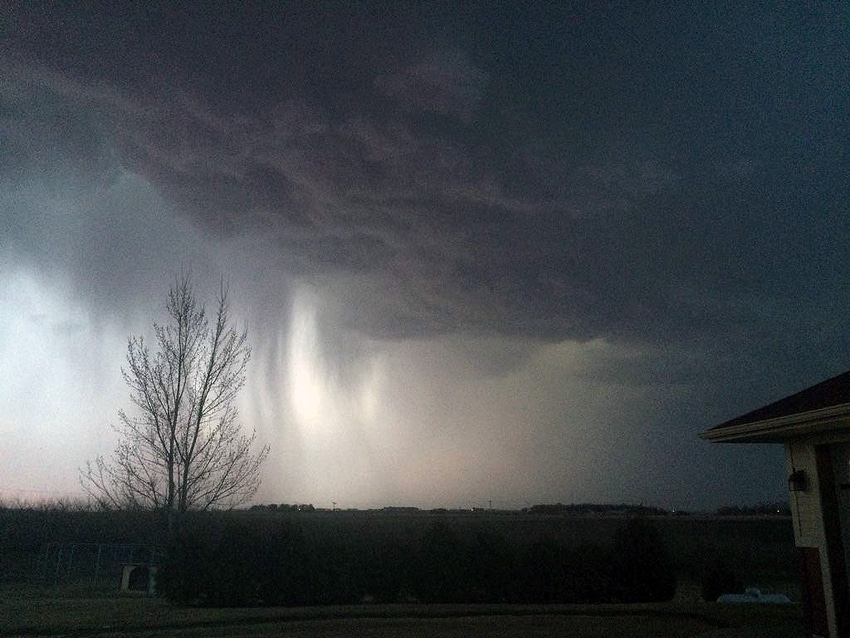May 13, 2016

Planting may be in the front of everyone’s mind, but farmers should not lose sight of nitrogen management, particularly after the recent rains. With the extra moisture, water movement through the soil creates reason for concern. If nitrogen fertilizer was applied to corn fields either last fall or this spring before the recent rains, potential nitrogen loss is likely.
Most inorganic nitrogen is in the form of nitrate. Nitrate in soil is subject to leaching losses when excess water drains below the active rooting depth, which is about 3-4 feet for corn. In the last two months (March and April) most areas across Nebraska have seen significantly more rainfall than long-term averages for the same period, causing many producers to wonder if their fields are at risk for nitrate leaching.
Estimating nitrate leaching risk
The University of Nebraska-Lincoln publishes a nitrogen modeling tool, Maize-N, that estimates corn nitrogen need and potential nitrogen losses based on historic and current weather data. Using real-time weather data as of May 1, 2016, simulation results of the Maize-N model suggest soils in most corn and soybean areas are likely very wet, with moisture content around field capacity. Some areas have been at this level for the past one to two weeks. As soil hardly retains water above field capacity, excess rainfall likely has drained down through the soil profile below soil rooting depth along with the nitrate in the soil water. In addition, nitrate that did not leach below the 3-4 foot depth is still at risk for further soil water movement, which could leach additional nitrogen beyond crop roots.
Assuming a silt clay loam soil texture and soil moisture around 70% of field capacity in the beginning of March, the Maize-N model estimated nitrate leaching at approximately 14% of the total nitrate remaining in mid-April 2016. For lighter soil textures the risk of nitrate leaching is greater while the opposite is true for heavier textures. For example, the average nitrate leaching was estimated to be 23% of total nitrate present in mid-April assuming sandy loam texture for all locations while the corresponding value was 9% for clay loam for all locations.
Because the soil in most fields has likely been fully recharged, further rainfall in the coming weeks will likely lead to more nitrate leaching.
It is important to point out that models are estimates and not exact numbers. Any number of factors may affect an estimate such as variability in rainfall amounts, soil moisture movement, temperature, etc. That is why these estimates should be taken in the context. One’s own sites will most certainly differ, but the important point is that nitrogen leaching is likely, and management plans must be assessed to prevent significant yield loss from nitrogen nutrition deficiencies that may show up later in the growing season. (See related article, Using Chemigation for In-Season N Application.)
Nitrogen management options
Fortunately, several tools are now available to assess the nitrogen status of your management system. The most rudimentary but yet invaluable tool is the soil sample. It may be a lot of work, but taking composite soil samples at different depths (0-8, 8-24, and 24-48 inches) and having them analyzed for ammonium and nitrate would give more confidence as to how much nitrogen is currently in the system, and where it is located. Is the bulk of the nitrogen in the lower depths? This should raise concerns for future losses.
Other tools are also available, such as chlorophyll meters, active crop canopy sensors and aerial imagery. These tools all require a growing crop and work best after the V8 growth stage, which is just beyond the window of most toolbar sidedress options. These tools are accurate if calibrated: They require nitrogen-rich strips to be used as the comparison. Sensors have been shown to be an effective management strategy for varying nitrogen rate throughout the field via high clearance N applicator. (See UNL Project SENSE introduction and 2015 results.) We realize not everyone will have access to these machines, and so what other options are there?
If the sensors need to be used beyond the point of when you can sidedress, think about using the PSNT, which is a 1-foot sample taken the first week of June. The ppm nitrate in this sample have been calibrated for Iowa, but not Nebraska. Consider how much N is currently in your system, and use the UNL N algorithm in Fertilizer Suggestions for Corn or use modeling tools like Maize-N to help estimate future N needs based on your field conditions.
Last but not least, some growers are set up to fertigate. Many shudder at the thought of putting more water on a field that is sopping wet, but later in the season, fertigation allows a grower to respond to potential deficiencies by delivering a timely application of N to the crop. We do not currently have guidelines specific to fertigation (we’re working on it), but by using the Nebguide Using a Chlorophyll Meter to Improve N Management, you can get a reasonable estimate of when and how much N to apply.
Of course all of these methods still require continuous monitoring of your corn crop and its response to changing weather and field conditions. Nitrogen is a tricky nutrient and needs to be watched carefully to prevent losses to both your bottom line and the environment.
You May Also Like




